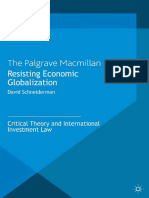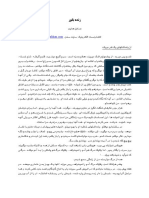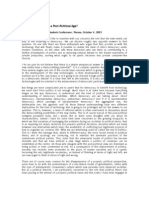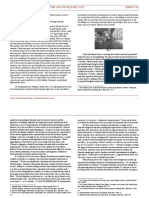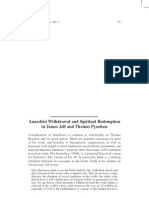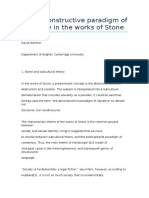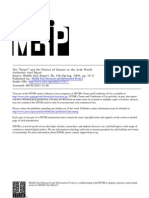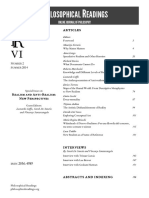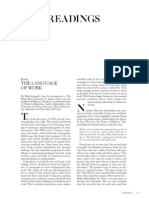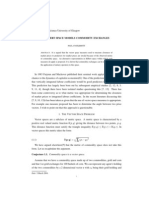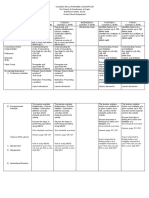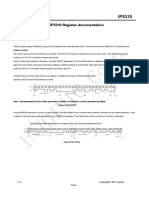Red Plenty
Red Plenty
Uploaded by
Paul CockshottCopyright:
Available Formats
Red Plenty
Red Plenty
Uploaded by
Paul CockshottOriginal Description:
Copyright
Available Formats
Share this document
Did you find this document useful?
Is this content inappropriate?
Copyright:
Available Formats
Red Plenty
Red Plenty
Uploaded by
Paul CockshottCopyright:
Available Formats
Red Plenty by Francis Spufford
Paul Cockshott May 15, 2010
This is a marvelous and unusual book. It sits in a remarkable way in between science popularisation, social history and ction. The author describes it variously as a novel whose hero is an idea and a fairytale. The hero idea, is that of optimal planning. The idea of running a planned economy in just such a way as to ensure that resources are optimally used in order to deliver the red plenty of the title. Combining real and imagined characters, politicians like Khrushchev, mathematicians and economists like Kantorovich and Nemchinov with ctionalised minor characters, it gives a gripping and apparently realistic picture of life in the USSR during the 50s and 60s. It is not a single narrative as one expects from historical ction. Instead it gives us a series of snapshots from the lives of individuals, separated by years. The common link is the project of the Cybernetic economic reformers, and the ambitions of Khrushchev to attain communist plenty. The author shows real skill as a science populariser, explaining such diverse topics as how the Pentode valve logic of the early BESM computers worked, to the molecular mechanics of the carcinogenesis mechanism that eventually killed its designer. He vividly portrays the enthusiasm and self condence of the USSR in the late 50s when Khrushchevs boasts that they would overtake the USA by 1980 and achieve communism seemed plausible. He gives a good didactic account both of the basic mechanisms of the Soviet Economy, and, through the lives of incidental characters paints a picture its real operation that is more detailed and convincing than any academic history. He traces the idea of cybernetic economic management from the hope of the 50s and early 60s to its sidelining under Kosygin, and the eventual relegation of Kantorovich to the less ambitious task of optimisating steel tube output for the oil and natural gas industry. Ironically, says Spufford, as growth rates slipped in the 70s, it was only the exploitation of petroleum for export that allowed Soviet living standards to rise. This is a book that should be read by anyone who is seriously interested in the possibility of a different sort of economy from the one we now have. It shows both the strengths, and the hidden weaknesses of the most serious attempt so far to construct an alternative to capitalism, an attempt that was born when the idea of a communist future was taken very seriously by a whole society. To read it is to be convinced that whatever the truth of standard leftist criticism of the USSR as being undemocratic and bureacratic, there was much more than that at issue in this tragedy. It raises real political and philosophical issues that would have to be faced by any future socialist project, and draws attention to a forgotten history that todays socialists 1
ignore at their peril. The bulk of what we read and hear about the USSR focuses on the 20s and 30s. The remaining 50 years of its history fade before the glamour, grandeur and horror of the early years. But the early 1960s, when Russia was already an industrial country, with many areas of internationally competitive technology in aviation, space, computing holds more relevant lessons for the European left than its early years. It is clear what lesson orthodox economists will draw. Its a timely exploration, now so many people have gone of the idea of markets, of why the alternative is worse.1 But such conclusions betray an unjustied and callous smugness. It is a smugness not justied by the elegaic last paragraph of the book. The restoration of the market mechanism in Russia was a vast controlled experiment. Nation, national character and culture, natural resources and productive potential remained the same, only the economic mechanism changed. If Western economists were right, then we should have expected economic growth and living standards to have leapt forward after the Yeltsin shock therapy. Instead the country became an economic basket-case. Industrial production collapsed, technically advanced industries atrophied, and livingstandards fell so much that the death rate shot up by over a third leading to some 7.7 million extra deaths.
If you were old, if you were farmer if you were a manual worker, the market was a great deal worse than even the relatively stagnant Soviet economy of Brezhnev. The recovery under Putin, such as it was, came almost entirely as a side effect of rising world oil prices, the very process that had operated under Brezhnev. But this does not excuse us from seriously considering the problems so vividly raised in the book. Spufford recounts how the attempt to follow the reformers recomendations and raise the price of food to provide more income for farmers provoked strikes by industrial workers, which where suppressed with great brutality. The same
1
The enlightened economists blog
scenario played itself out in Poland in the 70s and 80s, when any attempt to raise the ridiculously low subsidised meat prices led to strikes. Spufford brings out the disconnection between the recomendations of the reform economists and the real lives of the people that the reforms would impact on. Food subsidies were the bad conscience of inequality. They were necessary because without them, those on the lower wage rates could scarcely have survived. Marx had advocated that in the rst stage of communism everybody would be paid in labour vouchers not money - 1 hours work getting 1 hours vouchers. Goods would be directly priced in terms of the labour required to make them and social expenditure would be met out of a tax or time-levy on incomes. Soviet prices deviated considerably from labour values for two reasons: The well known subsidies on essential foods and housing The turnover tax was , I think calculated on the basis of total turnover not just wages, as such it was similar to the xed percent markup marx posited for prices of production. Given that due to subsidies, wages underestimated the real value of labour power, this sort of markup would mean that the deviation of prices from labor value would actually have been bigger than under capitalism. To have furthered Khrushchevs avowed aim of communism, Kantrovich would have had to propose egalitarian pay rates and a shift in state nance from turnover taxes to income taxes, before prices could be rationalised. Spufford gives greatest emphasis to the policies of those around Kantorovich and Nemchinov, who were advocating price reforms as part of a programme to allow optimal operation of the economy. Kantorovich argued that these prices - objectively determined valuations - arose out of the objective technical structure of the economy. If actual prices corresponded to objectively determined values, then the signals that these prices provided would guide individual factories to produce in accordance to what the plan needed. There is of course a strong similarity between this argument and that put forward by Western economists about the role of prices in guiding resource allocation in a market economy. It is probably no accident then that Kantorovich was the only Soviet economist to get a Nobel Prize for economics. But there was a fatal paradox in this whole notion, one that Spufford brought out in a meeting between Kosygin and a leading reformer : how were these optimal prices to be calculated? The maths was well understood, but the technical problems of handling that much data with 1960s computers were vast. And if Gosplan could concentrate the information and could have done the computations, then the indicative prices would have been unneccessary - the whole process of calculation could have been done in-natura with the Objective Valuations only having a eeting existence as coefcients within the matrices of the planning computers. So the programme of Kantorovich ended up requiring the same level of computing resources as that of his rival cyberneticist Victor Gluschov who apparently advocated the complete abolition of money - something supercially closer to Krushchevs vision of communism. In this context it is worth reading InterNyet: why the Soviet Union did not build a nationwide computer network 3
by Slava Gerovitch. It would have been interesting had Gluschov appeared as a character in the book, rather than just as someone who is refered to indirectly. In the afterword it becomes clear why Gluschov remains such a shadowy gure to Spufford. Spufford reveals that he relied entirely on English language sources. What he knew of Gluschov came from Gerovitchs brief account. All in all, let me say again, this is a book that should be read by anyone with a serious interest in economic alternatives.
You might also like
- Gunpla Judging Version 1Document43 pagesGunpla Judging Version 1api-669648727100% (1)
- 1.said OrientalismReconsideredDocument20 pages1.said OrientalismReconsideredAbdoukadirr SambouNo ratings yet
- How Countries Democratize - Samuel HuntingtonDocument39 pagesHow Countries Democratize - Samuel HuntingtonCedrick Cochingco SagunNo ratings yet
- Anderson 1998 - Spectre of Comparisons IntroDocument15 pagesAnderson 1998 - Spectre of Comparisons IntroDanielle0% (1)
- Muhammad Ali (The Fighter) - My Own StoryDocument2 pagesMuhammad Ali (The Fighter) - My Own StoryNanaPooh0% (1)
- HERSHATTER, Gail Et Al. Guide To Women's Studies in China PDFDocument226 pagesHERSHATTER, Gail Et Al. Guide To Women's Studies in China PDFEdelson ParnovNo ratings yet
- Kent Cooper - The Right To Know (1945)Document3 pagesKent Cooper - The Right To Know (1945)jommeyer100% (1)
- The Postsecular Political Philosophy of Jürgen Habermas: Translating the SacredFrom EverandThe Postsecular Political Philosophy of Jürgen Habermas: Translating the SacredNo ratings yet
- Financial Times-A Rare Interview With Jürgen Habermas (30.04.2010)Document7 pagesFinancial Times-A Rare Interview With Jürgen Habermas (30.04.2010)Ejz8a3ffNo ratings yet
- Dahl PolyarchyDocument6 pagesDahl PolyarchyGeorge Ungureanu100% (1)
- LeGoff, Mentality, A New Field For HistoriansDocument18 pagesLeGoff, Mentality, A New Field For HistoriansAdrianDawidWesołowskiNo ratings yet
- (Palgrave Macmillan Socio-Legal Studies) David Schneiderman (Auth.) - Resisting Economic Globalization - Critical Theory and International Investment Law-Macmillan Education UK (2013) PDFDocument228 pages(Palgrave Macmillan Socio-Legal Studies) David Schneiderman (Auth.) - Resisting Economic Globalization - Critical Theory and International Investment Law-Macmillan Education UK (2013) PDFPrakhar Bhardwaj100% (1)
- EricDocument26 pagesEricetweber-1No ratings yet
- Storytelling User Experience DesignDocument13 pagesStorytelling User Experience Designjavier7314No ratings yet
- Martial Gueroult The History of Philosophy As A Philosophical Problem 1Document26 pagesMartial Gueroult The History of Philosophy As A Philosophical Problem 1AmrElsherifNo ratings yet
- Dead Man Walking The Aldo Moro Kidnap An PDFDocument13 pagesDead Man Walking The Aldo Moro Kidnap An PDFTheo PapadopoulosNo ratings yet
- Festschrift For I.w..2 PDFDocument198 pagesFestschrift For I.w..2 PDFYiannis000No ratings yet
- Francis Fukuyama: Our Posthuman FutureDocument6 pagesFrancis Fukuyama: Our Posthuman FutureHugo Chesshire100% (1)
- Nations, Spaces, and Ruling Serious GamesDocument78 pagesNations, Spaces, and Ruling Serious GamesBruce CaronNo ratings yet
- Taking Herodotus PersonallyDocument13 pagesTaking Herodotus PersonallyAnonymous Jj8TqcVDTy100% (1)
- POSTMODERNISM AND ITS RELEVANCE TO AFRICAN DEVELOPMENT - Timbee AkuulDocument5 pagesPOSTMODERNISM AND ITS RELEVANCE TO AFRICAN DEVELOPMENT - Timbee AkuulFrancis Abulude100% (1)
- Nettl - Apples and OrangesDocument7 pagesNettl - Apples and OrangesHugo QueirozNo ratings yet
- EAGLETON, Terry. Base and Superstructure RevisitedDocument11 pagesEAGLETON, Terry. Base and Superstructure RevisitedFalossNo ratings yet
- Administrative Law: The Past, The Present and The Future.Document22 pagesAdministrative Law: The Past, The Present and The Future.Corey GauciNo ratings yet
- Processing of Visible Language PDFDocument530 pagesProcessing of Visible Language PDFlazut273No ratings yet
- A Critique of Roman RosdolskyDocument6 pagesA Critique of Roman RosdolskyIraldoMatiasNo ratings yet
- 2017 Book MobilitiesOfKnowledge PDFDocument305 pages2017 Book MobilitiesOfKnowledge PDFVictor AttahNo ratings yet
- Zende Be Goor PDFDocument11 pagesZende Be Goor PDFمحمد نصرتیNo ratings yet
- Kieran McKeown Auth. Marxist Political Economy and Marxist Urban Sociology A Review and Elaboration of Recent DevelopmentsDocument294 pagesKieran McKeown Auth. Marxist Political Economy and Marxist Urban Sociology A Review and Elaboration of Recent DevelopmentsFelipe Reyes VallejosNo ratings yet
- Haidt - 2013 - Moral Psychology For The Twenty-First CenturyDocument18 pagesHaidt - 2013 - Moral Psychology For The Twenty-First CenturykenlightNo ratings yet
- 2009 THE ANALYTICAL TURN IN SOCIOLOGY HedstromDocument20 pages2009 THE ANALYTICAL TURN IN SOCIOLOGY HedstromGabriel Carvalho Il100% (1)
- Theory of Social FieldsDocument2 pagesTheory of Social FieldsMariana Toledo0% (1)
- Chantal MouffeDocument5 pagesChantal Mouffeelrik2894No ratings yet
- 2006 Modernity and OrderDocument10 pages2006 Modernity and OrderquevengadiosyloveaNo ratings yet
- Swedish and German Liberalism: From Factions to Parties 1860–1920From EverandSwedish and German Liberalism: From Factions to Parties 1860–1920No ratings yet
- Philosophical Methodology in Classical Chinese and German PhilosophyFrom EverandPhilosophical Methodology in Classical Chinese and German PhilosophyNo ratings yet
- Bourdieu Comes To Town. Pertinence, Principles, ApplicationsDocument16 pagesBourdieu Comes To Town. Pertinence, Principles, ApplicationsMaría ColladoNo ratings yet
- Does Science Need PhilosophyDocument9 pagesDoes Science Need PhilosophyEduardo Luiz SchillingNo ratings yet
- Anarchy in PynchonDocument7 pagesAnarchy in PynchonlasphodelaNo ratings yet
- The Deconstructive Paradigm of Narrative in The Works of StoneDocument5 pagesThe Deconstructive Paradigm of Narrative in The Works of StoneMichelFoucaultNo ratings yet
- Modernization Theory and The Sociological Study of DevelopmentDocument21 pagesModernization Theory and The Sociological Study of DevelopmentMahathir MohamadNo ratings yet
- Natural Law EssayDocument386 pagesNatural Law EssayMichal VaryšNo ratings yet
- 'Street' and The Politics of Dissent in The Arab World - Asef BayatDocument9 pages'Street' and The Politics of Dissent in The Arab World - Asef BayatnailsatliganNo ratings yet
- McNay (2001) - Meditations On Pascalian MeditationsDocument18 pagesMcNay (2001) - Meditations On Pascalian MeditationsMaxi ImpróvolaNo ratings yet
- Summary of Intro and Chapter One of Latour's Inquiry Into Modes of ExistenceDocument11 pagesSummary of Intro and Chapter One of Latour's Inquiry Into Modes of ExistenceDaveShaw100% (1)
- Enlightenment Today Author(s) : John Rajchman Source: Log, No. 11 (Winter 2008), Pp. 131-142 Published By: Stable URL: Accessed: 14/06/2014 15:07Document13 pagesEnlightenment Today Author(s) : John Rajchman Source: Log, No. 11 (Winter 2008), Pp. 131-142 Published By: Stable URL: Accessed: 14/06/2014 15:07Guido PalacinNo ratings yet
- Introduction To Theory of Literature-YaleDocument1 pageIntroduction To Theory of Literature-YalePablo Silva SaundersNo ratings yet
- Altieri - Cavell & Wittgenstein On Morality: The Limits of AcknowledgmentDocument16 pagesAltieri - Cavell & Wittgenstein On Morality: The Limits of Acknowledgmentfotovk88No ratings yet
- Cambridge Companion To Nozick's BookDocument27 pagesCambridge Companion To Nozick's BookChris Gossage100% (1)
- Luca Baccelli - Political Imagination, Conflict and Democracy. Machiavelli's Republican Realism PDFDocument22 pagesLuca Baccelli - Political Imagination, Conflict and Democracy. Machiavelli's Republican Realism PDFarierrefbNo ratings yet
- Rorty, Richard - Pragmatism, Categories, and Language (1961)Document28 pagesRorty, Richard - Pragmatism, Categories, and Language (1961)Fer VasNo ratings yet
- Jens Beckert, Richard Bronk - Uncertain Futures - Imaginaries, Narratives, and Calculation in The Economy-Oxford University Press (2018)Document346 pagesJens Beckert, Richard Bronk - Uncertain Futures - Imaginaries, Narratives, and Calculation in The Economy-Oxford University Press (2018)Tony KurianNo ratings yet
- Al-Azmeh (1981) - The Articulation of OrientalismDocument20 pagesAl-Azmeh (1981) - The Articulation of OrientalismOmar MohammedNo ratings yet
- Field Theories of Consciousness - ScholarpediaDocument5 pagesField Theories of Consciousness - Scholarpediavova825100% (1)
- Walsh - Livy's Preface and The Distortion of History PDFDocument16 pagesWalsh - Livy's Preface and The Distortion of History PDFCamila BelelliNo ratings yet
- The Dismantling of Brazil's Old Republic: Early Twentieth Century Cultural Change, Intergenerational Cleavages, and the October 1930 RevolutionFrom EverandThe Dismantling of Brazil's Old Republic: Early Twentieth Century Cultural Change, Intergenerational Cleavages, and the October 1930 RevolutionNo ratings yet
- (China in Transformation) Tony Saich, Biliang Hu (Auth.) - Chinese Village, Global Market - New Collectives and Rural Development-Palgrave Macmillan US (2012) PDFDocument224 pages(China in Transformation) Tony Saich, Biliang Hu (Auth.) - Chinese Village, Global Market - New Collectives and Rural Development-Palgrave Macmillan US (2012) PDFirwanbasri86No ratings yet
- H of Luigi Trastulli and Other Stories - Form and Meaning in OraDocument393 pagesH of Luigi Trastulli and Other Stories - Form and Meaning in OraBungau AlinNo ratings yet
- Realism and Anti-Realism PDFDocument159 pagesRealism and Anti-Realism PDFben_65No ratings yet
- The Language of WorkDocument5 pagesThe Language of WorkBradley L. GarrettNo ratings yet
- Challenging Multi CoresDocument27 pagesChallenging Multi CoresPaul CockshottNo ratings yet
- Testing Marx With Input Output TablesDocument27 pagesTesting Marx With Input Output TablesPaul CockshottNo ratings yet
- Turing and MaterialismDocument2 pagesTuring and MaterialismPaul CockshottNo ratings yet
- Multicore Challenge in Vector Pascal: P Cockshott, Y GduraDocument29 pagesMulticore Challenge in Vector Pascal: P Cockshott, Y GduraPaul CockshottNo ratings yet
- Interrupts: How To Do 2 Things at The Same TimeDocument22 pagesInterrupts: How To Do 2 Things at The Same TimePaul CockshottNo ratings yet
- Sics A TalkDocument12 pagesSics A TalkPaul CockshottNo ratings yet
- Death On The Campsies (Updated)Document40 pagesDeath On The Campsies (Updated)Paul CockshottNo ratings yet
- NasmDocument67 pagesNasmPaul Cockshott100% (1)
- Strings, Records and ArraysDocument36 pagesStrings, Records and ArraysPaul CockshottNo ratings yet
- Tiny BasicDocument31 pagesTiny BasicPaul CockshottNo ratings yet
- Useful x86 Instructions This Is A Very Small Subset of The Available In-Structions But Should Be Enough For Your Pur - PosesDocument31 pagesUseful x86 Instructions This Is A Very Small Subset of The Available In-Structions But Should Be Enough For Your Pur - PosesPaul CockshottNo ratings yet
- Hilbert Space Models Commodity ExchangeDocument7 pagesHilbert Space Models Commodity ExchangePaul CockshottNo ratings yet
- Extending Handivote To Handle Digital Economic Decisions: Karen Renaud & Paul CockshottDocument21 pagesExtending Handivote To Handle Digital Economic Decisions: Karen Renaud & Paul CockshottPaul CockshottNo ratings yet
- HeapsDocument67 pagesHeapsPaul CockshottNo ratings yet
- Hilbert Space Models Commodity ExchangesDocument9 pagesHilbert Space Models Commodity ExchangesPaul CockshottNo ratings yet
- Checklist School HeadDocument1 pageChecklist School HeadMila LemanaNo ratings yet
- The Origin and Development of Management Accounting: M Shotter School of Accountancy University of PretoriaDocument27 pagesThe Origin and Development of Management Accounting: M Shotter School of Accountancy University of PretoriaJulius MwambiNo ratings yet
- All-Flo Diaphragm Full Product Line 2019 - BrochureDocument6 pagesAll-Flo Diaphragm Full Product Line 2019 - BrochureRosendo GarcíaNo ratings yet
- Math Ed 04: TrigonometryDocument5 pagesMath Ed 04: TrigonometryCharles SilerioNo ratings yet
- Charging Lines CA CL CCLDocument2 pagesCharging Lines CA CL CCLjeremy_chan_35No ratings yet
- Đáp-Án-Đề-Kiểm-Tra-Giữa-Học-Kỳ-1-Năm-2023-2024-Môn-Tiếng-Anh-10 2Document5 pagesĐáp-Án-Đề-Kiểm-Tra-Giữa-Học-Kỳ-1-Năm-2023-2024-Môn-Tiếng-Anh-10 24qsh8s7kp8No ratings yet
- Brochure Agenda Sales Operational Planning 2Document4 pagesBrochure Agenda Sales Operational Planning 2AhmadNo ratings yet
- The Army ValuesDocument10 pagesThe Army ValuesMylesNo ratings yet
- Instrument Alarms, Trips and Set Points List: 0 1980 RPM 1980 RPM VAIDocument1 pageInstrument Alarms, Trips and Set Points List: 0 1980 RPM 1980 RPM VAInastyn-1No ratings yet
- Lesson Plan 14Document16 pagesLesson Plan 14Jay BolanoNo ratings yet
- Wountsop Sonna Rodrigue - CVDocument3 pagesWountsop Sonna Rodrigue - CVdashNo ratings yet
- 30:60:90 PlanDocument10 pages30:60:90 PlanSocrates VergaraNo ratings yet
- Types of Algorithms PresentationDocument10 pagesTypes of Algorithms Presentationvaltierra1494No ratings yet
- PWV4 BS 001Document348 pagesPWV4 BS 001July HuaquistoNo ratings yet
- F - PDF Geography - Book-2 - E-JHA-2Document15 pagesF - PDF Geography - Book-2 - E-JHA-2Pooja AgarwalNo ratings yet
- Collaboration in The 21st Century Implications For AssessmentDocument6 pagesCollaboration in The 21st Century Implications For AssessmentAmar YusufNo ratings yet
- FIDP For PassDocument3 pagesFIDP For Passmarlon anzanoNo ratings yet
- ML 07 WeldingDocument11 pagesML 07 WeldingDeepakNo ratings yet
- Psychology MTTC ReportDocument2 pagesPsychology MTTC Reportapi-590350469No ratings yet
- Orbits in A Central Force Field: Bounded OrbitsDocument11 pagesOrbits in A Central Force Field: Bounded OrbitsSameerNo ratings yet
- Steps To Improve Roads On Black Cotton SoilsDocument13 pagesSteps To Improve Roads On Black Cotton SoilsPerkresht PawarNo ratings yet
- Pre-Writing Strategies PPT SimpleDocument18 pagesPre-Writing Strategies PPT Simpleanitamartinez0% (1)
- M-Pro MobileDocument4 pagesM-Pro MobileDrakkarNo ratings yet
- Writing A Publishable Paper-CampusDocument35 pagesWriting A Publishable Paper-Campuslienraserolf0% (1)
- Table of Specification SY 2022 2023 Q3.1Document2 pagesTable of Specification SY 2022 2023 Q3.1Jessalyn De VillaNo ratings yet
- Can AnalyzerDocument39 pagesCan Analyzerallaboutanalog100% (1)
- Humanistic Psychology and Metapsychology: Amedeo GiorgiDocument29 pagesHumanistic Psychology and Metapsychology: Amedeo GiorgimacNo ratings yet
- IP5310 REG V1.2.zh-CN - enDocument12 pagesIP5310 REG V1.2.zh-CN - enJonasNo ratings yet











